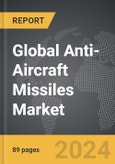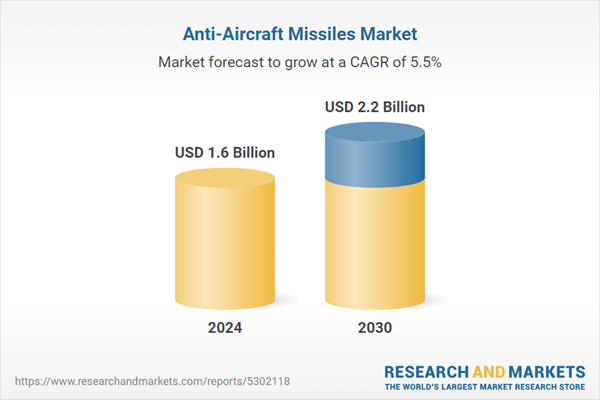The global market for Anti-Aircraft Missiles was valued at US$1.6 Billion in 2024 and is projected to reach US$2.2 Billion by 2030, growing at a CAGR of 5.5% over the analysis period 2024-2030. This comprehensive report provides an in-depth analysis of market trends, drivers, and forecasts, helping you make informed business decisions. The report includes the most recent global tariff developments and how they impact the Anti-Aircraft Missiles market.
Segments: Segment (Anti-Aircraft Missiles).
Geographic Regions/Countries: World; United States; Canada; Japan; China; Europe (France; Germany; Italy; United Kingdom; Spain; Russia; and Rest of Europe); Asia-Pacific (Australia; India; South Korea; and Rest of Asia-Pacific); Latin America (Argentina; Brazil; Mexico; and Rest of Latin America); Middle East (Iran; Israel; Saudi Arabia; United Arab Emirates; and Rest of Middle East); and Africa.
The analysts continuously track trade developments worldwide, drawing insights from leading global economists and over 200 industry and policy institutions, including think tanks, trade organizations, and national economic advisory bodies. This intelligence is integrated into forecasting models to provide timely, data-driven analysis of emerging risks and opportunities.
Global Anti-Aircraft Missiles Market - Key Trends and Drivers Summarized
What Makes Anti-Aircraft Missiles the Unseen Guardians of the Skies?
Anti-aircraft missiles have evolved significantly since their inception, becoming one of the most sophisticated elements of modern military arsenals. But what exactly are anti-aircraft missiles, and how did they come to occupy such a pivotal role in air defense systems? Initially developed during World War II, the first iterations were rudimentary and primarily used for point-defense against slow-moving aircraft. Today, these missiles are engineered to target a broad array of aerial threats, ranging from agile fighter jets to high-speed cruise missiles and even drones. Modern anti-aircraft systems can be classified into several categories based on range and altitude capabilities: Short-Range Air Defense (SHORAD), Medium-Range Surface-to-Air Missiles (SAM), and High-Altitude Long-Range systems such as the S-400 and the Patriot missile systems. The sophistication of radar and guidance systems, the integration of multi-layered defenses, and the ability to counter stealth technologies are some hallmarks of contemporary anti-aircraft missiles, making them indispensable assets for both offensive and defensive military operations. Moreover, the evolution of network-centric warfare has enhanced the real-time data exchange and precision targeting, allowing these systems to engage multiple targets simultaneously, thereby revolutionizing airspace security dynamics.How Do Anti-Aircraft Missiles Achieve Such Accuracy and Effectiveness?
The operational technology behind anti-aircraft missiles is a complex amalgamation of guidance systems, propulsion technologies, and advanced warheads. How do these components harmonize to deliver precise hits on high-speed, maneuvering targets? To start with, the guidance system is at the core of an anti-aircraft missile’s effectiveness. These systems employ various technologies, such as infrared homing, radar guidance, or command guidance, depending on the type of threat and engagement conditions. For example, radar-guided missiles like the American RIM-66 Standard Missile utilize active radar to independently track targets, while infrared-guided missiles like the AIM-9 Sidewinder home in on the heat signatures emitted by enemy aircraft engines. The propulsion systems, often using solid or liquid propellants, are tailored to provide exceptional maneuverability and speed, enabling missiles to chase down fast and agile aerial targets. Warheads, on the other hand, are designed with proximity fuses that detonate when the missile is near the target, maximizing damage through shrapnel dispersion rather than relying solely on direct hits. Such technological sophistication is vital because modern aerial threats include hypersonic missiles and highly maneuverable stealth aircraft, which require anti-aircraft systems to have superior tracking and engagement capabilities.Who Relies on Anti-Aircraft Missiles and Why Are They So Essential?
The deployment of anti-aircraft missiles is not confined to just major military superpowers; they are used by a wide array of nations and even non-state actors. Why has this technology become so universal? The reason lies in their strategic value. Anti-aircraft missiles are essential for maintaining aerial superiority, deterring enemy aircraft from entering restricted airspace, and protecting critical infrastructure such as military bases, industrial sites, and civilian assets. Nations such as the United States, Russia, and China have pioneered the development of advanced anti-aircraft systems that form the backbone of their Integrated Air Defense Systems (IADS). Smaller countries, facing a limited defense budget, have opted for cost-effective, mobile solutions like the Man-Portable Air Defense Systems (MANPADS), which are easy to deploy and can be concealed in diverse terrains. The recent rise in drone warfare and the proliferation of Unmanned Aerial Vehicles (UAVs) has further underscored the necessity for versatile anti-aircraft solutions that can neutralize not only traditional aircraft but also smaller, harder-to-detect flying platforms. Furthermore, the adoption of anti-aircraft missile systems by non-state actors, such as rebel groups or paramilitary forces, has become a pressing security concern. This trend demonstrates the need for ongoing advancements in missile technology to ensure robust defense against increasingly accessible and diverse aerial threats.What Factors Are Driving the Growth of the Anti-Aircraft Missile Market?
The growth in the anti-aircraft missile market is driven by several factors, primarily advances in threat detection technology, evolving military doctrines, and changing geopolitical landscapes. One of the most prominent drivers is the rapid development of fifth-generation fighter aircraft, which necessitates cutting-edge anti-aircraft systems to counter their stealth and electronic warfare capabilities. The increasing deployment of UAVs and drones for reconnaissance, surveillance, and even attack roles has pushed nations to invest in anti-drone missile systems that can adapt to these smaller, less detectable targets. Additionally, the global focus on the modernization of defense infrastructure, particularly in Asia-Pacific and the Middle East, is boosting demand for sophisticated missile defense systems. Consumer behavior in this sector reflects a clear preference for multi-layered and integrated systems that can provide a comprehensive shield against both conventional and unconventional aerial threats. Rising defense budgets, especially in nations like India and Saudi Arabia, are propelling market growth as these countries look to acquire advanced missile systems to bolster their defensive and strategic capabilities. Moreover, the focus on creating domestically produced defense technology in several countries, such as Turkey’s Hisar project or India’s Akash program, signifies a shift towards self-reliance, driving competition and technological innovation within the market. Finally, the intensification of regional conflicts and the ongoing arms race among major powers are creating an urgent need for nations to secure air superiority, thus acting as a substantial growth catalyst for the anti-aircraft missile market worldwide.Report Scope
The report analyzes the Anti-Aircraft Missiles market, presented in terms of units. The analysis covers the key segments and geographic regions outlined below.Segments: Segment (Anti-Aircraft Missiles).
Geographic Regions/Countries: World; United States; Canada; Japan; China; Europe (France; Germany; Italy; United Kingdom; Spain; Russia; and Rest of Europe); Asia-Pacific (Australia; India; South Korea; and Rest of Asia-Pacific); Latin America (Argentina; Brazil; Mexico; and Rest of Latin America); Middle East (Iran; Israel; Saudi Arabia; United Arab Emirates; and Rest of Middle East); and Africa.
Regional Analysis
Gain insights into the U.S. market, valued at $421.0 Million in 2024, and China, forecasted to grow at an impressive 8.2% CAGR to reach $496.0 Million by 2030. Discover growth trends in other key regions, including Japan, Canada, Germany, and the Asia-Pacific.Why You Should Buy This Report:
- Detailed Market Analysis: Access a thorough analysis of the Global Anti-Aircraft Missiles Market, covering all major geographic regions and market segments.
- Competitive Insights: Get an overview of the competitive landscape, including the market presence of major players across different geographies.
- Future Trends and Drivers: Understand the key trends and drivers shaping the future of the Global Anti-Aircraft Missiles Market.
- Actionable Insights: Benefit from actionable insights that can help you identify new revenue opportunities and make strategic business decisions.
Key Questions Answered:
- How is the Global Anti-Aircraft Missiles Market expected to evolve by 2030?
- What are the main drivers and restraints affecting the market?
- Which market segments will grow the most over the forecast period?
- How will market shares for different regions and segments change by 2030?
- Who are the leading players in the market, and what are their prospects?
Report Features:
- Comprehensive Market Data: Independent analysis of annual sales and market forecasts in US$ Million from 2024 to 2030.
- In-Depth Regional Analysis: Detailed insights into key markets, including the U.S., China, Japan, Canada, Europe, Asia-Pacific, Latin America, Middle East, and Africa.
- Company Profiles: Coverage of players such as Airbus Defense & Space, Aselsan A.S., BAE Systems PLC, Elbit Systems, General Dynamics and more.
- Complimentary Updates: Receive free report updates for one year to keep you informed of the latest market developments.
Some of the 34 companies featured in this Anti-Aircraft Missiles market report include:
- Airbus Defense & Space
- Aselsan A.S.
- BAE Systems PLC
- Elbit Systems
- General Dynamics
- Hanwha Corporation
- Israel Aerospace Industries Ltd.
- JSC Concern Vko 'Almaz-Antey'
- Kongsberg Gruppen
- L3 Harris
- Leonardo S.P.A.
- Lockheed Martin Corporation
- MBDA
- Northrop Grumman Corporation
- Rafael Advanced Defense Systems
- Raytheon Company
- Rheinmetall AG
- Saab AB
- Thales Group
- The Boeing Company
Tariff Impact Analysis: Key Insights for 2025
Global tariff negotiations across 180+ countries are reshaping supply chains, costs, and competitiveness. This report reflects the latest developments as of April 2025 and incorporates forward-looking insights into the market outlook.The analysts continuously track trade developments worldwide, drawing insights from leading global economists and over 200 industry and policy institutions, including think tanks, trade organizations, and national economic advisory bodies. This intelligence is integrated into forecasting models to provide timely, data-driven analysis of emerging risks and opportunities.
What’s Included in This Edition:
- Tariff-adjusted market forecasts by region and segment
- Analysis of cost and supply chain implications by sourcing and trade exposure
- Strategic insights into geographic shifts
Buyers receive a free July 2025 update with:
- Finalized tariff impacts and new trade agreement effects
- Updated projections reflecting global sourcing and cost shifts
- Expanded country-specific coverage across the industry
Table of Contents
I. METHODOLOGYII. EXECUTIVE SUMMARY2. FOCUS ON SELECT PLAYERSIII. MARKET ANALYSISIV. COMPETITION
1. MARKET OVERVIEW
3. MARKET TRENDS & DRIVERS
4. GLOBAL MARKET PERSPECTIVE
UNITED STATES
CANADA
JAPAN
CHINA
EUROPE
FRANCE
GERMANY
ITALY
UNITED KINGDOM
SPAIN
RUSSIA
REST OF EUROPE
ASIA-PACIFIC
AUSTRALIA
INDIA
SOUTH KOREA
REST OF ASIA-PACIFIC
LATIN AMERICA
ARGENTINA
BRAZIL
MEXICO
REST OF LATIN AMERICA
MIDDLE EAST
IRAN
ISRAEL
SAUDI ARABIA
UNITED ARAB EMIRATES
REST OF MIDDLE EAST
AFRICA
Companies Mentioned (Partial List)
A selection of companies mentioned in this report includes, but is not limited to:
- Airbus Defense & Space
- Aselsan A.S.
- BAE Systems PLC
- Elbit Systems
- General Dynamics
- Hanwha Corporation
- Israel Aerospace Industries Ltd.
- JSC Concern Vko 'Almaz-Antey'
- Kongsberg Gruppen
- L3 Harris
- Leonardo S.P.A.
- Lockheed Martin Corporation
- MBDA
- Northrop Grumman Corporation
- Rafael Advanced Defense Systems
- Raytheon Company
- Rheinmetall AG
- Saab AB
- Thales Group
- The Boeing Company
Table Information
| Report Attribute | Details |
|---|---|
| No. of Pages | 89 |
| Published | April 2025 |
| Forecast Period | 2024 - 2030 |
| Estimated Market Value ( USD | $ 1.6 Billion |
| Forecasted Market Value ( USD | $ 2.2 Billion |
| Compound Annual Growth Rate | 5.5% |
| Regions Covered | Global |









